|


|

|

The Somme, 1916
Many a home has been darkened with the shadow of
bereavement as the Casualty List, day by day has
flashed across the ocean. The sympathy of the whole
community has gone forth, both to the brave Lads’ who
have suffered, and to their anxious and sorrowing
relatives at home. The gloom of these dark days,
however, will be lightened up by the glorious heroism,
which the Regiment displayed, and the glory it has
achieved both for itself and the old Colony which it
proudly represents (Diocesan Magazine 124).
The Somme offensive in the summer of 1916 had its origins in Anglo-French plans to bring the war
to a rapid close. At the end of 1915 the war was going badly for the Allies. The Eastern Front was
in disarray. The Gallipoli offensive had failed. The Allies desperately needed success, and
concentrated their efforts on the Western Front. From this sprang the ill-fated Somme offensive.
Newfoundland soldiers in St. John’s Road support trench, July 1, 1916.
This
picture was taken before the start of the attack, July 1, 1916.
Courtesy of the Provincial Archives of Newfoundland and Labrador (PANL NA-3105), St. John’s,
Newfoundland.
 (51 Kb)
(51 Kb)
|
 |
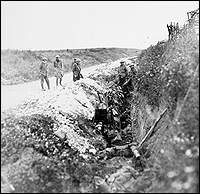
|
Allied plans were upset by a German decision to “bleed France white” at Verdun.
The Verdun offensive began in February 1916 and siphoned off French forces intended for
the Somme offensive. In consequence, the Somme offensive became a largely British effort, designed
to relieve beleaguered French troops at Verdun, and to cause a decisive breakthrough in the German
lines.
Sir Beauvoir de Lisle’s 29th Division, the Newfoundland Regiment included, left Egypt for
northwest Europe in the spring of 1916. The Fourth Army’s 20-kilometre front, which included the 29th,
extended a few kilometres beyond the hamlet of Serre to Maricourt, where it formed a junction with the
French Sixth Army. The Germans held the whole of this front in great strength; a three-tiered system of
forward trenches was well dug in, with extensive protective wire,
and capable of surviving sustained bombardment. Beyond that, at ranges between 2,000 and 5,000
metres, the Germans had constructed a second line of trenches and were working farther back on yet
a third. This network of heavily defended lines presented a formidable obstacle to any attacking force.

|
 |
A captured German trench, n.d.
Courtesy of the Provincial Archives of Newfoundland and Labrador (PANL B-2-44), St. John’s,
Newfoundland.
 (67 Kb)
(67 Kb)
|
The 29th Division, comprising the 86th, 87th and 88th Brigades, occupied the forward slope of the
most westerly of a series of well-defined ridges that ran southeast toward the Ancre River. In a
shallow valley ahead of the British line lay the little village of Beaumont Hamel, just within the
German front-trench system and overlooked by Hawthorn Ridge. The Newfoundland Regiment, as
part of the 88th Brigade, moved into the firing line on Easter Eve, April 22, for the first time since
Gallipoli. Some 300 to 500 metres distant, down a grassy slope, lay the German front lines, heavy
barbed wire entanglements guarding the approaches. The German 119th Reserve Regiment, tough
and experienced, had turned the natural defences of a deep Y-shaped ravine into
one of the strongest positions on the entire Somme front. For the next two months the
Newfoundlanders shifted from forward area to reserve, starting intensive training with the 88th on
ground that resembled the approaches to the German lines. Few battles have been so meticulously
planned. In the end it mattered little. The task eventually assigned to the 88th and the Newfoundland
Regiment was not the one for which it had trained.
The offensive called for the Fourth Army to move along a 20-kilometre front, driving the
enemy from its first and second positions. In the Beaumont Hamel area, this meant a 5,000-metre
advance for the 29th Division. The 86th and 87th Brigades were to lead off the advance securing the
First Line while the 88th, with its leading battalions, the Essex and the Newfoundland Regiment were
to attack, under artillery cover, the German positions on the Beaucourt Road. Successive assaulting
waves were expected to overwhelm the enemy. An intense week-long bombardment
before the attack was intended to soften enemy resistance and cut the protective wire.
An enemy shell bursting at Beaumont Hamel, 1916.
Courtesy of the Provincial Archives of Newfoundland and Labrador (PANL B-2-42), St. John’s,
Newfoundland.
 (11 Kb)
(11 Kb)
|
 |
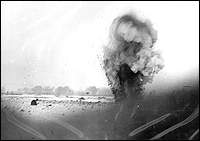
|
The Newfoundlanders were confident that they were well prepared. Weeks of hard training had
conditioned them physically, and General de Lisle had told them about the power of the British
offensive and the weakness of the German position. “Tell all friends that
the 1st Newfoundland is O.K., and never feels downhearted. We will make you all proud of us some
day,” wrote Private Frank ‘Mayo’ Lind on the 29th. It would be his last letter home
(Lind 157).
Bad weather postponed the offensive until July 1, allowing extra time for rest, reflection and final
preparations, including readying the 30 kilograms (66 pounds) of personal equipment each soldier was
to carry into battle. At 9:00 p.m. on June 30, the regiment turned out for the final time: 25 officers,
776 NCOs and other ranks. Among the young men preparing for their first experience
of going over the top there was little evidence of foreboding. “It is surprising to see how happy and
light-hearted everyone is,” Lieutenant Owen Steele noted in his diary, “and yet this is undoubtedly
the last day for a good many.” Optimism prevailed. “The climax of our troubles will be reached within
the next few days after which the day of peace will quickly draw near” (Steele 339–40). It was his last
entry. He was killed six days later.
Promptly at 6:25 a.m. on July 1, the artillery bombardment began. At 7:20 a.m. the mines
under Hawthorn Ridge exploded, warning the Germans that an attack was about to begin. The
subsequent 10-minute delay in launching the offensive also allowed the Germans time to prepare for
battle. Private John Ryan recalled thinking after the explosion, “That’s it, we’re
licked” (Atwater 213).
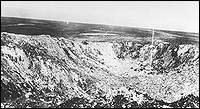
|
 |
Crater formed by the mine at Hawthorne Ridge, 1916.
Courtesy of the Provincial Archives of Newfoundland and Labrador (PANL B-2-45), St. John’s,
Newfoundland.
 (45 Kb)
(45 Kb)
|
Almost immediately, the opening phase of the 29th Division’s attack began to falter under withering
enemy fire. Confusion was compounded by poor communication. General de Lisle mistook German
flares for a signal of success from the attacking 87th Brigade, and ordered the 88th Brigade to move,
with the Essex and Newfoundland Regiments advancing “as soon as possible.” But the Essex soldiers
were unable to leave their trenches because of the large number of dead and wounded soldiers.
Thus it was that the Newfoundlanders moved off on their own at 9:15 a.m., their objective the first
and second line of enemy trenches, some 650 to 900 metres away. In magnificent order, practiced
many times before, they moved down the exposed slope towards No Man’s Land, the rear sections
waiting until those forward reached the required 40-metre distance ahead. No friendly artillery fire
covered the advance. A murderous cross-fire cut across the advancing columns and men began to
drop, at first not many but then in large numbers as they approached the first gaps in their own wire.
Private Anthony Stacey, who watched the carnage from a forward trench with Lieutenant-Colonel Hadow, stated
that “[m]en were mown down in waves,"” and the gaps cut the night before were “a proper trap for
our boys as the enemy just set the sights of the machine guns on the gaps in the barbed wire and fired”
(Stacey 17A). Doggedly, the survivors continued on towards The Danger Tree. “The only visible sign
that the men knew they were under this terrific fire,” wrote one observer, “was that they all
instinctively tucked their chins into an advanced shoulder as they had so often done when fighting
their way home against a blizzard in some little outport in far off Newfoundland” (Raley 37–40). Few
advanced beyond it. Stacey recalled that from his vantage point he “could see no moving, but lots of
heaps of khaki slumped on the ground” (Stacey 19). The few who did get to the German lines were
horrified to discover that the week-long artillery barrage that preceded the attack had not cut the
German barbed wire. This fact was known by commanders the night before, thanks to a report by a
Newfoundland reconnaissance team. The news was dismissed on the grounds that it was due to the
“nervousness of men who were facing battle for the first time” (Gilham). As a consequence, the
majority of the soldiers who reached the enemy trenches were killed, tangled in the uncut wire.
Barbed wire at Beaumont Hamel, 1916.
Courtesy of the Provincial Archives of Newfoundland and Labrador (PANL NA-2732), St. John’s,
Newfoundland.
 (48 Kb)
(48 Kb)
|
 |
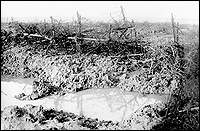
|
In less than 30 minutes it was all over. At 9:45 a.m., Hadow, who had witnessed
the annihilation of his regiment from a forward position, reported to Brigade Headquarters that the
attack had failed. Incredibly, he was ordered to collect up any unwounded and resume the attack.
Fortunately, wiser counsel prevailed and the order was countermanded. Throughout the
day survivors attempted the long and dangerous journey back to their own lines, many being an easy
target for enemy snipers and artillery fire. Ron Dunne lay wounded on the battlefield for several days.
On the second day, convinced that he would soon die, his thoughts turned homeward to Bonavista
Bay and his mother. “I said me prayers,” he recalled, and then drifted off, unaware that rescue was
on the way (Memorial).
That night the search began for survivors. When the roll call was taken, only 68 responded. The full
cost would not be known for several days. The final figures revealed that the regiment had been
virtually wiped out: 710 killed, wounded or missing. Most were struck down before they
reached beyond their own front line (Middlebrook 269).
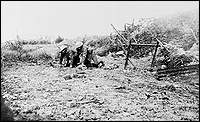
|
 |
A wounded man is brought in at the Battle of Albert, 1916.
Courtesy of the Provincial Archives of Newfoundland and Labrador (PANL NA-6067), St. John’s,
Newfoundland.
 (47 Kb)
(47 Kb)
|
The Battle of the Somme was the great turning point in the war. The hopes of a generation that went
to war so willingly in 1914 were crushed once and for all. The “Big Push” did not bring the war to
a swift conclusion. The battle lasted until November with inconclusive results and unleashed a
bloodbath that continued unabated for another two years. The Somme laid waste to Kitchener’s
Army, raised amidst the enthusiasm of the first year of the war. It also annihilated the Newfoundland
Regiment, the colony’s premier contribution to the imperial war effort. The results were devastating,
leaving Newfoundlanders bereft and confused, with a sense of loss that marked an entire generation.
The legacy of the Battle of Beaumont Hamel continues to the present day, with special
commemorations taking place every July 1.
The Battle of the Somme has been haunted by controversy. Some historians have seen it as the
beginning of the end for the Central Powers. Others are more cynical, seeing
a needless waste of life in the lengthy offensive, characterized by incredible courage and inept
leadership—“Lions led by Donkeys” (Howard 510). The debate rages on. The only consensus seems
to be that poor communications and a blind faith in the offensive were factors in the terrible
consequences of the Somme.
The Department of Veterans Affairs Canada has allowed us to reproduce on the site their,
“Self-Guided Tour to the Beaumont Hamel Memorial Park.” To maximize the viewing area, the tour
opens into its own window. On the map is a series of numbers; moving the cursor over the number
will bring up explanatory text in English or French.
Open tour
(English |
French)

|

|
 |